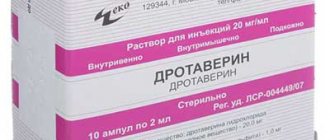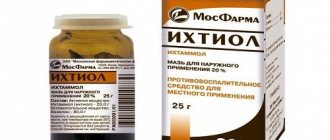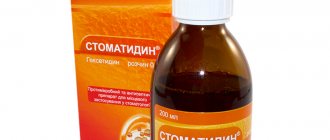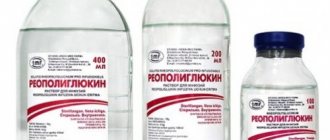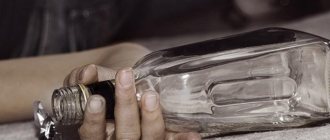pharmachologic effect
The formula of the drug, which consists of two substances, allows you to obtain a pronounced analeptic effect . The medicine stimulates the vasomotor and respiratory centers, affecting the structures of the medulla oblongata .
Directly affects the myocardium , increasing its sensitivity to stimulation of the sympathetic nervous system and improving metabolic processes in tissues.
Under the influence of the drug, the tone of blood vessels in the periphery increases. The secretion of the bronchial glands is stimulated and pulmonary blood flow improves, increasing ventilation of the lungs.
Instructions for use of Sulfocamphocaine
Everything you need to know about Sulfocamphocaine - its features, indications and contraindications, possible complications, method of application - can be read in the instructions.
Dosage regimen and nuances of administration
The medication is used parenterally, that is, bypassing the gastrointestinal tract. An injection with the drug is given in different ways:
- intramuscularly;
- subcutaneously;
- intravenously - stream or drip.
For adult patients, it is recommended to administer 2 ml once - the contents of one ampoule. The frequency of injections can be up to three times a day, but the dose of 12 ml cannot be exceeded.
Before giving the injection, it is better to dilute the medication in a 0.9 percent sodium chloride solution. How long the treatment will last is determined only by a specialist, taking into account how effectively Sulfocamphocaine relieves acute manifestations of pathologies.
In the treatment of chronic diseases, the course of medication is increased to a month. In this case, it is recommended to give injections into the muscle or under the skin.
Overdose
The use of any drug in an increased dosage inevitably leads to undesirable consequences. Sulphocamphocaine is no exception. An overdose of the drug makes itself felt by the following symptoms:
- headaches;
- dizziness.
in case of acute overdose:
- the face turns red;
- motor activity increases pathologically;
- the patient is delirious;
- convulsions similar to epileptic ones appear.
To get rid of these symptoms, medications that have an antipsychotic effect and the ability to suppress seizures are used. If overexcitation is not clearly expressed, ordinary sedatives and tranquilizers are sufficient.
Analogs
Level 4 ATC code matches: Vasonate
Phosphaden
Hawthorn fruit
Preductal
Meldonium
Angiosil Retard
Ranexa
Lily of the valley tincture
Neocardil
Rimecore
Triductane
ATF-Long
Hawthorn tincture
Triductan MV
Trimectal MV
Trimectal
Neoton
Predisin
Trimetazidine
Tivortin Aspartate
Sulfocaine , Sulfoprocaine .
Analogs for pharmacological action: Cordiamin , Etimizol .
Side effects
One of the features of the drug is that it does not often provoke the development of complications, the list of which is small. Side effects include:
- dyspeptic disorders - flatulence, indigestion, problems with stool;
- various allergic reactions - itching, rash, urticaria, swelling, bronchospasm, angioedema, anaphylactic shock;
- a drop or increase in blood pressure, usually in patients suffering from hypotension, chest pain, rapid heartbeat;
- clouding of consciousness, headache, paresthesia (sensitivity disorder characterized by burning, tingling, goosebumps), tremor (shaking in the hands), convulsions of striated skeletal muscles;
- methemoglobinemia (increased levels of methemoglobin in the blood - a form of hemoglobin in which iron is ferric).
If these symptoms appear, you should immediately consult a specialist who will help eliminate them.
Reviews of Sulphocamphocaine
You can find numerous reviews about the medicine on the forums. Doctors prescribe it in many cases, even those that are not indicated. For example, the use of the drug for pneumonia . Injections are prescribed for acute conditions, for old people after injuries (hip fracture) to reduce congestion in the lungs, maintain the heart and circulatory system.
Tolerability is usually good if the doses and regimen are followed. You need to remember to be careful when taking hypotensive drugs , as the medicine lowers blood pressure.
Sulphocamphocaine is widely used for dogs in a wide variety of cases and diseases, since it stimulates and supports the cardiovascular system in animals well. The drug is used in the same way for cats - there are reviews of its use both for injuries (for example, after being hit or hit by a car) and for liver diseases in pets. Among the disadvantages, it is noted that the injections cause weakness in animals, apparently due to a drop in pressure.
Indications and contraindications for use
The drug Sulfocamphocaine can be prescribed for urgent conditions requiring emergency medical care:
- problems with the functioning of the respiratory system (acute and chronic), causing insufficient oxygen saturation of the blood;
- heart failure with a sharp deterioration in myocardial contractions in acute form (most often in elderly patients);
- difficulty breathing caused by intoxication due to various infections and pneumonia;
- anaphylactic shock syndrome is a severe form of a systemic allergic reaction, characterized by a rapid drop in blood pressure and the development of multiple organ failure;
- cardiogenic shock is a sharp deterioration in heart function with a rapid drop in pressure.
The medication is used for acute alcohol poisoning, as well as for overdose of sleeping pills (to a small extent).
Contraindications include:
- periods of bearing a child and breastfeeding;
- increased sensitivity to novocaine;
- intolerance to the components of the product;
- epilepsy and predisposition to the development of seizures.
Sulphocamphocaine price, where to buy
The price of Sulphocamphocaine in Moscow is 149 rubles. The average price in Russia is from 99 to 168 rubles. per pack 10 ampoules.
In Ukraine, the cost of medicine in pharmacies is about 55 UAH.
- Online pharmacies in RussiaRussia
- Online pharmacies in UkraineUkraine
ZdravCity
- Sulphocamphocaine solution for injection 10% 2ml 10 pcs. JSC Ufimsky Vitam.Z-D
141 rub. order
Pharmacy Dialogue
- Sulphocamphocaine (amp. 10% 2ml No. 10) FS-UfaVita
135 rub. order
show more
Pharmacy24
- Sulphocamphocaine-Darnitsa 2 ml No. 10 solution for injection PrAT" Pharmaceutical company "Darnitsa", Ukraine
91 UAH. order
Composition and release form
Sulphocamphocaine N10 is a 10% solution of sulfocamphoric acid, poured into ampoules (ten pieces in a cardboard pack - 5 vessels each in two blister packs). One ampoule has a volume of 2 ml.
The composition of the drug includes:
- active component - sulfocamphoric acid in the amount of 49.6 mg (anhydrous), supplemented with procaine (50.4 mg);
- additionally - liquid for injection.
The concentration of components is given per 1 ml.
The injection solution is essentially a clear liquid, yellowish or colorless.
Pharmacological properties
Pharmacodynamics.
Sulfocamphocaine-Darnitsa belongs to the group of analeptic drugs. The mechanism of action of the drug is due to stimulation of the central nervous system, primarily the centers of the medulla oblongata, both directly and through the carotid sinus. The drug tones the respiratory and vasomotor centers, enhances metabolic processes in the heart muscle, increasing its sensitivity to the influence of sympathetic nerves. Sulphocamphocaine-Darnitsa has a direct effect on blood vessels - blood is redistributed, the vessels of the abdominal organs narrow, the tone of the venous vessels increases, the blood flow to the heart slightly increases, coronary blood flow and blood supply to the brain and lungs improve. The cardiotonic effect is associated with an adrenosensitizing effect, increased respiration and glycolysis processes associated with the process of phosphorylation of high-energy compounds.
Pharmacokinetics.
Sulfocamphocaine-Darnitsa is quickly absorbed when administered subcutaneously, intramuscularly, or intravenously. In the body, during metabolism, it undergoes oxidation and conjugation with glucuronic acid. Metabolites are excreted mainly by the kidneys, and the urine has a drug-like odor. Partially excreted with exhaled air, through the respiratory tract and with bile.
special instructions
Particular care should be taken when prescribing the drug to patients with hypotension, since novocaine, which is part of the drug, can further lower blood pressure.
Prescription for children
Sulfocamphocaine is not used in pediatrics.
During pregnancy and lactation
The use of the described product during pregnancy and breastfeeding is strictly prohibited.
Drug interactions
Sulphocamphocaine interacts with various drugs, including:
- drugs with a depressant effect on the nervous system - their effectiveness is reduced;
- anticholinesterase substances – a weakening of the effect is also observed;
- Suxamethonium – prolongs the blockade of nerves and muscles;
- monoamine oxidase inhibitors - there is a high probability of increased blood pressure;
- cardiac glycosides, diuretics, painkillers, steroid hormones - the analeptic effect of Sulfocamphocaine is enhanced.
Alcohol compatibility
During treatment with the described medication, you should stop drinking alcohol. But after alcohol poisoning, the drug is prescribed.
Directions for use and doses
Sulfocamphocaine-Darnitsa is prescribed subcutaneously, intramuscularly or intravenously (slowly, stream or drip) to adults in a single dose of 2 ml. For dilution, a 0.9% sodium chloride solution should be used. If necessary, the drug can be used 2-3 times a day. The maximum daily dose for adults is 12 ml.
In acute cases, the drug is administered intravenously.
For chronic respiratory failure and heart failure, apply intramuscularly or subcutaneously. The course of treatment can be 20-30 days.
Children.
The medicine should not be used in children.


